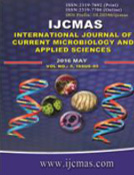


 National Academy of Agricultural Sciences (NAAS)
National Academy of Agricultural Sciences (NAAS)

|
PRINT ISSN : 2319-7692
Online ISSN : 2319-7706 Issues : 12 per year Publisher : Excellent Publishers Email : editorijcmas@gmail.com / submit@ijcmas.com Editor-in-chief: Dr.M.Prakash Index Copernicus ICV 2018: 95.39 NAAS RATING 2020: 5.38 |
In the present investigation the effect of stone crushing dust pollution on the growth performance and yield status of Rice (Oryza sativa) was studied in specified land areas of village Arap, Patna. The results indicated that the germination frequency of seeds, shoot length, root length, chlorophyll content, total carbohydrate and protein contents, and grain yield of Rice (Oryza sativa) were severely affected by stone dust pollution. The treated seeds showed only 68 to 70 % germination in comparison to control (85%). The chlorophyll content in stone dust treated seedlings was found to be less (Chl-a 65mg/g and 18.75mg/g of leaf tissue in comparison to control (chl-a 90.75 and chl-b 25.25mg/g of leaf tissue). The total carbohydrate was also less, 115.35µg/100mg of leaf tissue in comparison to control (127.25µg/100mg of leaf tissue). The total protein was less in the range of 94.75 to 96.15mg/gm of leaf tissue in comparison to control (103.50mg/gm of leaf tissue). The yield status of treated plants was significantly declined to115.50 - 116.65gm/plant in comparison to control 125gm/plant). The plants that grown in control land area were healthy as compared to plants grown in the stone dust treated land areas. A loss in chlorophyll-a and chlorophyll-b content in leaves of plants treated with stone dust supported the argument that the chloroplast is the primary site of attack by stone crushing dust pollutants. The present results clearly indicate that the stone crushing dust adversely affect the growth and yield status of Rice (Oryza sativa).
 |
 |
 |
 |
 |